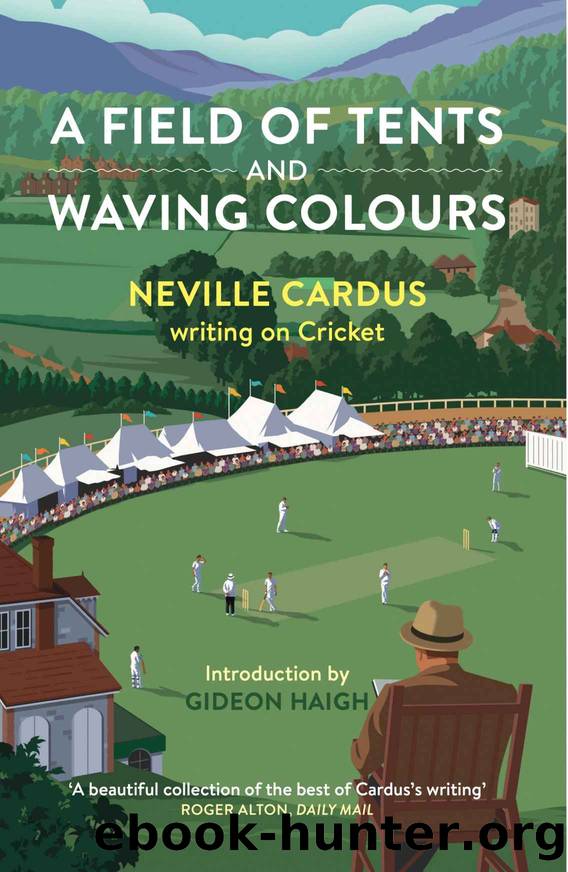A Field of Tents and Waving Colours: Neville Cardus Writing on Cricket by Cardus Neville

Author:Cardus, Neville [Cardus, Neville]
Language: eng
Format: epub
ISBN: 9781916045385
Publisher: Safe Haven
Published: 2020-06-08T05:00:00+00:00
Hobbs in the Nets
Not long ago I had the good fortune to see Hobbs at practice. He used a beautiful white bat, and as he made stroke after stroke he would glance solicitously at the face of his blade as though he were reluctant to do it hurt. The noise made by his hits was music to every cricketer present â a clean, solid noise, with no overtones. One could imagine, and envy, the thrill of delight that passed through Hobbs as he made these strokes â delight running its current from the batâs end up the arms, down the spine, and all over the body. Batsmen in other nets ceased their ineffectualities as Hobbs practised; they ceased them for very shame and also because the art of Hobbs held them in thrall.
Hobbs himself was not in serious vein. He was merely improvising like the pianist who lets his fingers move irresponsibly and experimentally over the keyboard; like the artist who in a ârough studyâ will indulge in bold âchancyâ sweeps of the crayon. But it is during these improvisatory moments that we sometimes get a peep that takes us deeper into the mind and character of an artist than his finished work permits. The finished work often gives you the artist âdressed up for the occasionâ, so to speak. He is, of course, himself in a finished work, but plus something conditioned by his medium and his public. It is by means of his improvisations that the artist can break free from the tyranny of his medium.
A quarter of an hour of Hobbs in the nets revealed to us a Hobbs above that ruthless law which, by the grim paradox of all art, is the source of perfection and the death of it. Here was a Hobbs free to use his bat as waywardly as he chose, and every stroke he made was made to serve no ends other than the artistâs. The strokes were worth nothing in runs â no Surrey axe had to be ground in the nets. They were strokes thrown away on the air, squandered by our greatest batsman in a moment that found him free to the uttermost. In a quarter of an hour only three balls passed Hobbsâs bat. The practice almost guaranteed that this summer will find him as masterful as ever.
From behind the net the technique of Hobbs is, so to speak, seen under a magnifying lens. Or it is as though one were looking at a painting with oneâs eyes almost glued to the canvas. You can see that now more of energy, even of roughness, goes into Hobbsâs cricket than is apparent when watching him from a distance. He grips his bat in the middle of the handle as he waits for the ball, but frequently when he plays back the right hand drops almost to the bottom of the handle. This denotes strong right forearm leverage in Hobbsâs defensive strokes. Immediately the bowler begins his run Hobbs seems
Download
This site does not store any files on its server. We only index and link to content provided by other sites. Please contact the content providers to delete copyright contents if any and email us, we'll remove relevant links or contents immediately.
| Cricket | Field Hockey |
| Lacrosse | Rugby |
| Track & Field | Volleyball |
Going Long by Editors of Runner's World(2298)
The Happy Runner by David Roche(2195)
Yoga For Dummies by Georg Feuerstein(1420)
Becoming Boston Strong by Amy Noelle Roe(1351)
Legacy by Kerr James(1272)
Winger by Smith Andrew(1226)
The Little Red Book of Running by Scott Douglas(1175)
Wodehouse At the Wicket by P.G. Wodehouse(1096)
Bowerman and the Men of Oregon by Kenny Moore(1093)
The Way of the Runner by Adharanand Finn(1075)
5050 by Dean Karnazes(1063)
Running Your First Marathon by Andrew Kastor(1043)
Swim, Bike, Run - Eat by Tom Holland(1026)
The Coming Storm by Nigel McCrery(989)
Blade Runner by Oscar Pistorius(988)
Spiked (Blocked Book 3) by Jennifer Lane(981)
The Grade Cricketer by Dave Edwards(953)
The Shared Origins of Football, Rugby, and Soccer by Christopher Rowley(952)
The Amazing Test Match Crime by Adrian Alington(945)
